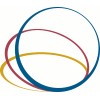
The Effect of 3% Diquafosol Ophthalmic Solution on Visual Display Terminal-associated Dry Eye
Dry Eye SyndromesComputer Vision Syndrome1 moreThis study aims to evaluate the efficacy and safety of 3% Diquafosol Ophthalmic Solution for visual display terminal (VDT)-associated dry eye and to investigate the mechanism of treatment.

Lutein Supplementation in Healthy Children
Eye FatigueDiet2 moreThis is a single site, randomized, double-blind placebo controlled parallel arm study assessing the effects of 6 months lutein supplementation on cognitive and visual outcomes in healthy children exposed to excessive digital screen time.

Effect of Exercises on Computer Vision Syndrome
Neck PainDry Eye Syndromes4 moreComputer vision syndrome characterized as a complex of eye and vision problem related with activities which increase stress for close to vision. It includes a group of visual symptoms which occur from the extended viewing of the digital screen, when the demands of the task exceed the abilities of the viewer. Computer vision syndrome is an umbrella term that envelops many eye and environment-related problem that happen when the viewing need of the task increase the visual capability of the computer user which cause inefficacy to focus appropriately on computer images. Computer vision syndrome is also known as Digital Eye Strain.

Evaluate the Safety and Efficacy of Calcitonin Gene-Related Peptide (CGRP) Antagonists in Patients...
Dry EyeAsthenopiaSafety and Efficacy of Medications for Migraine in Patients with Dry Eye Disease or Asthenopia

Oculomotor Response While Using a Helmet Display Incorporating an Accommodation-vergence Stress...
Visual FatigueOperational military personnel are increasingly using virtual or augmented reality headsets in the field or in training. However, these devices cause a conflict between accommodation (focus to see clearly) and vergence (alignment of both eyes on the object being viewed) that can be a source of visual fatigue and altered visual and perceptual abilities. Although techniques exist to limit this conflict for screen-based stimuli, the use of helmet visuals (or immersive headsets) adds technological complexity. Indeed, since accommodation on the screen of the helmet visual is impossible (i.e., distance too small) for the human visual system, lenses are used to virtually shift the image (referred to as a collimated image) so that accommodation can occur much further away. However, this material configuration also modifies the vergence, thus causing a conflict between accommodation and additional vergence that persists regardless of the attenuation technique used. In this study, the investigator proposed to modify the image display to take into account the technical features of the helmet to correct this techno-dependent conflict. This study is aimed at determining whether the setting recommended by the algorithm developed by the investigator limits visual fatigue better than the conventional setting recommended by manufacturers or a subjective setting controlled by the user.

Randomized Clinical Trial of Bifocal Lenses Versus Computer-specific Progressive Addition Lenses...
Refractive ErrorPresbyopia2 moreThis is a research study designed to test the utility of D-shaped bifocal lenses and PRIO Computer Lenses for persons using a computer. We hypothesize that lenses specially designed for computer use may allow more comfortable and productive work on a computer.

Effectiveness of an Eye-Cervical Re-education Program in Chronic Neck Pain
Neck PainEye StrainThe aim of the present study is to value the effectiveness of an Eye-Cervical Re-education Program (ECRP) to decrease pain and increase mobility in the cervical area compared to a Combined Physiotherapy Protocol (CPP) in patients with chronic neck pain symptoms.

Connecting Contact Lenses and Digital Technology
AsthenopiaContact Lenses3 moreThis study seeks to address whether or not different types of daily disposable soft contact lenses may be a beneficial option for patients complaining of eye strain and visual discomfort while using digital devices.

Reducing Eye Strain and Anxiety Using a Digital Intervention During Online Learning Class Recess...
AnxietyDigital Eye StrainThe primary aim of the current study is to conduct a cluster-randomized control trial to evaluate the effectiveness of a novel digital intervention in reducing anxiety and digital eye strain compared to usual care among Chinese children during the period of home confinement.

Effects of Different Add Powers on the Comfort and Productivity of Computer Users With Fixed or...
Refractive ErrorsAsthenopiaThe aim of this study is to examine the relationship between optical blur from poor refractive corrections (glasses) of older workers using computers and their productivity and comfort in the workplace. The investigators believe that improving the visual status of subjects who use computers will have a beneficial effect on productivity and visual comfort.
